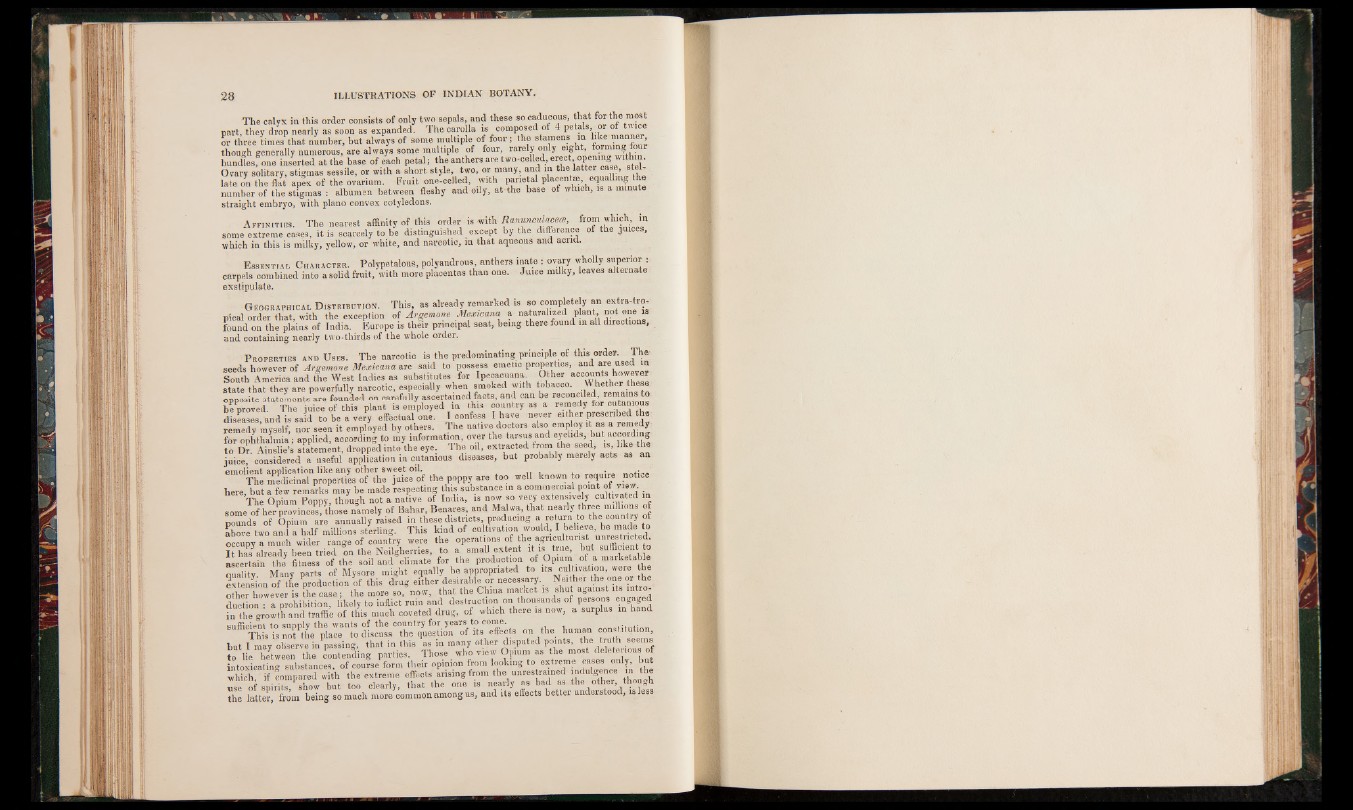
The calyx in this order consists of only two sepals, and these so caducous, that for the most
part, they drop nearly as soon as expanded. The. carolla is composed of 4 petals, or of tu ice
or three times that, number, but always of some multiple of four; the stamens in like manner,
though generally numerous, are always some multiple of four, rarely only eight, forming four
bundlesfone inserted at the base of each petal; the anthers are two-celled, erect opening within.
Ovary solitary, stigmas sessile, or with a short style, two, or many, and in the latter case, stel-
late on the flat apex of the ovarium. Fruit one-celled, with parietal placentae, equalling the
number of the stigmas : albumen between fleshy and oily, at the base of which, is a minute
straight embryo, with piano convex cotyledons.
A f f in it ie s . The nearest affinity of this order is -with RanuncuUcea, from which, in
some extreme cases, it is scarcely to be distinguished except by the difference of the juices,
which in this is milky, yellow, or white, and narcotio, m that aqueous and acrid.
E ssent ia l C haracter. Polypetalous, polyandrous anthers inate : ovary wholly s”Per»°r j
carpels combined into a solid fruit, with more placentas than one. Juice milky, leaves alternate
exstipulate.
G eographical D is t r ibu t io n . This, as already remarked is so completely an extra-tro-
pical order that, with the exception of Argemone Mexiccma a naturalized plant not one is
found on the plains of India. Europe is their principal seat, being there found mall directions,
and containing nearly two-thirds of the whole order.
P ro p er t ie s and U s e s . The narcotic is the predominating principle of this order. The
seeds however of Argemone Mexicana are said to possess emetic properties, and are used in
South America and the West Indies as substitutes Tor Ipecacuana Other accents however
state that they are powerfully narcotic, especially when smoked with tobacco. Whether' these
opposite statements are founded on carefully ascertained facts, and can be reconciled remains to
be proved. The juice of this plant is employed in this country as a remedy for
diseases, and is said to be a very effectual one. I confess I have never either presenhed the
remedy myself, nor seen it employed by others. The native doctors also employ it as a remedy
for ophthalmia; applied, according to my information, over the tarsus and eyelids, but according
to Dr Ainslie’s statement, dropped into the eye. The oil, extracted from the seed, is like the
juice, considered a useful application in cutamous diseases, but probably merely acts as an
emolient application like any other sweet oil. . HBBI
The medicinal properties of the juice of the poppy are too well known to require notice
here, but a few remarks may be made respecting this sunstance in a commerc.al point of view
The Opium Poppy, though not a native of India, is now so very extensively cultivated in
some of her provinces! those namely of Bahar, Benares, and Malwa, that ^ a rly three mi hons of
pounds of Opium are annually raised in these districts, producing a return to the country of
above two andP a half millions sterling. This kind of cultivation would, I believe, be made to
occupy a much wider range of country were the operations of the agriculturist unrestricted.
I t has^already been tried on the Neilgherries, to a small extent it is true, hut sufficient to
ascertain the fitness of the soil and climate for the production of Opium of a marketable
quality Many parts of Mysore might equally be appropriated to its cultivation, were the
ex tension of the production of this drag either desirable or necessary. Neither the one or the
other however is the case; the more so, now, that the China market is shut against its introduction
• a prohibition, likelv to inflict ruin and destruction on thousands of persons engaged
in the growth and traffic of this much coveted drug, of which there is now, a surplus m hand
sufficient to supply the wants of the country for years to come. „
™ This is not foe place to discuss the question of its effects on the human constitution,
hut I may observe in passing, that in this as in many other disputed points, the trn h seems
to lie between the contending parties. Those who view Opium as the most deleterious of
intoxicating substances, o f course fo rm foeir opinion from looking to extreme cases only but
which, if Compared with the extreme effects arising from the unrestrained '" dn,Kence
use of spirits show but too clearly, that the one is nearly as bad as the other though
the latter, from being so much more common among us, and its effects better understood, is less